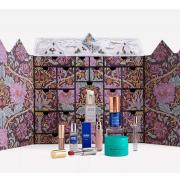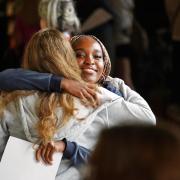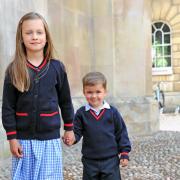Celebrating 10 seasons of The Great British Sewing Bee has judge Patrick Grant in a reflective mood.
“I’m super proud of it. Because not only is it a really fun show, one of the warmest and kindest shows on telly, it has done so much to transform people’s attitudes towards clothing and textiles,” the Scottish designer and presenter says.
Grant has championed sustainability in fashion on the show since it started in 2013, and he’s noticed a difference.
“In this series now, two of our contestants, without being asked, made multiple garments out of old textiles,” Grant, 51, says.
“I think the way we view our clothes and the way we view the value of every piece of clothing and textile we have in our homes has changed so dramatically.”
Grant says 10 seasons of the show – where home sewers take on a series of challenges, vying for the title of Britain’s Best Amateur Sewer – is in “large part responsible for a very big change in people’s attitudes” because it has “in a quiet and nice way made people think very differently about the clothes they have and how they buy”.

Designer Esme Young, 75, joined the show as a judge in 2016 and asserts that Grant himself has been “a big influence on sustainability”, particularly in an era where our attitudes to clothes are so far removed from what she grew up with.
“As a teenager, we bought everything from jumble sales – we’d alter it, but really badly. We didn’t care, just as long as it was as short as we wanted it to be and as tight as we wanted it,” she laughs.
“I have now stopped buying clothes – I’m not going to buy any more clothes. I know people get a high from buying new clothes, but it doesn’t last very long.”
The show has made an impact, but there’s still a long way to go in a world where fast fashion reigns supreme.
“I think we’re moving in the right direction, but there’s a big job to do,” Grant notes.
“There are a small number of people who know that they should be doing things differently and have actually changed the way they behave, then there’s a slightly bigger group of people who know they should be doing things differently, but either haven’t made that switch because it’s inconvenient or simply they can’t afford to.
“But then there’s a much, much bigger group of people who are still not aware of the impact that our addiction to fashion is having on the planet.”
While a message of sustainability has been present in the show since the beginning, a lot as changed for the 10th season.
When coming up with challenges for the contestants, Grant says “we’re always trying to think about what’s happening in the world of clothing today, and that has changed so much”.
The first season in 2013 was very much “back to basics”, he remembers, with the first ever challenge “an A-line skirt – but it was the most basic A-line skirt you’ve ever seen”.
The challenge was revisited for series 10 but with an update. Grant says: “We did a much more difficult version of an A-line skirt in denim, which was a great challenge.

“Looking back at those original challenges and seeing how far home sewers have come and how far we’ve come in our appreciation for clothes – also just seeing how sophisticated people have become at turning something old into something new.”
A new challenge sees contestants take old wedding dresses and transform them into party frocks.
“It was a brilliant, brilliant challenge because it showed you just how much you can do,” Grant explains. “I think if you look at those early things, they looked a little crafty… But now they genuinely make the most incredible pieces of clothing, which anybody will be happy to wear.”
That’s perhaps the biggest change: while the competition was originally focused on skill, Grant says: “Now, if you’re going to win this show, you have to have creativity and skill. And Esme was a big part of that – to begin with, we were a much more technical show, but when Esme took over, the creativity of the contestants was so much more of what Esme wanted to see.”
Creativity is “really, really important for me”, Young confirms. “I believe that people express who they are in what they make and what they wear.
“I think that’s always been in my life, being creative. As a child, I did sewing, embroidery, I drew. That was really important for me – that’s how I started designing.”

Another big change for 2024 is a new judge, with Ghosts actor Kiell Smith-Bynoe following in the footsteps of Claudia Winkleman, Joe Lycett and Sara Pascoe.
It was a new endeavour for Smith-Bynoe, 35, who had never presented a TV show before – and often found himself faced with tears from emotional contestants. So was he good at handling the sewers’ tears?
“My method was sort of going, ‘Oh, you’re crying again’ – so I don’t know if that would be considered as ‘good with tears’,” he jokes.
“I was surprised at how often tears would happen. I’ve seen the show and I know that people are extremely invested and do get emotional and are all doing it for different reasons. Some people are doing it in memory of someone, or because sewing was a thing they did with someone who’s no longer here – all different reasons.”
He had the difficult job of telling people when they were eliminated from the competition, saying: “I’m sure there’s a subconscious part of their brain that goes, it’s my fault. So I have to deal with that – it’s actually quite tough for me. It was a learning experience.
“And, of course, I haven’t done it before – I haven’t presented before. I also didn’t realise how much hard work it was. When I was a contestant [in the 2021 celebrity Christmas special] Sara [Pascoe] made it seem really easy… but I had a lot of fun doing it.”
And funny moments are definitely the ones the judges remember from their years on the show.
Grant remembers pogoing on set with Young in series five (“I think I managed to bounce Esme about 10 years across the floor – but that was pre-health and safety”) while Young fondly thinks of when the duo dressed up as Sonny and Cher.
One thing that’s stayed the same is how much downtime the judges have while the contestants are hard at work at the challenges.

“We’re in a little room together, and I’m always playing music on my Bluetooth speakers,” Young says, while she also sews her own clothes (“really fun – it’s like you’re achieving something”).
Grant remembers when Winkleman presented the show, saying: “Claudia and I used to play Boggle incessantly in the quiet time that we were not on set. We played boggle for hours and hours and hours, we had a Boggle ladder and all the various members of the crew also got involved.
“Annoyingly, Claudia is fantastically good at Boggle – I’m quite good at Boggle, but she’s better.”
A decade in, everyone involved seems convinced of the continued place of a show like The Great British Sewing Bee.
“Creativity helps people look at things in a different way,” Young explains.
“One thing about Sewing Bee is it has encouraged a lot of people to take up sewing, which I think is brilliant. You’re being creative, you’re solving problems, you’re making things for yourself. Sewing is a great skill.”
The Great British Sewing Bee airs on BBC One and BBD iPlayer


























